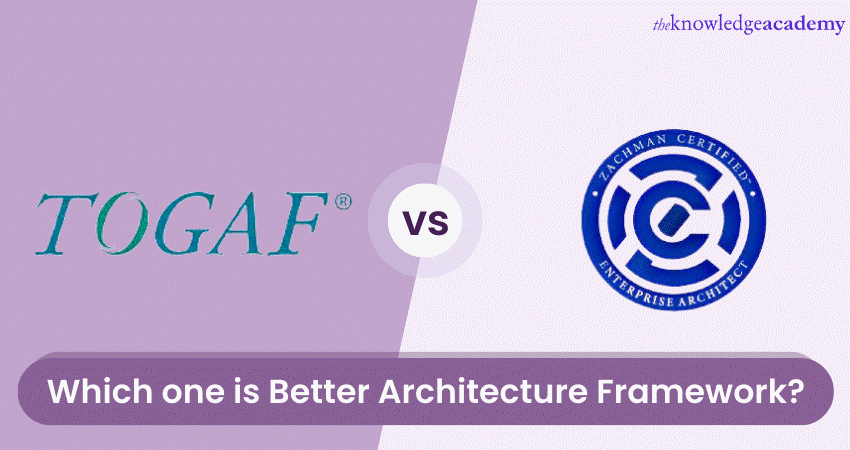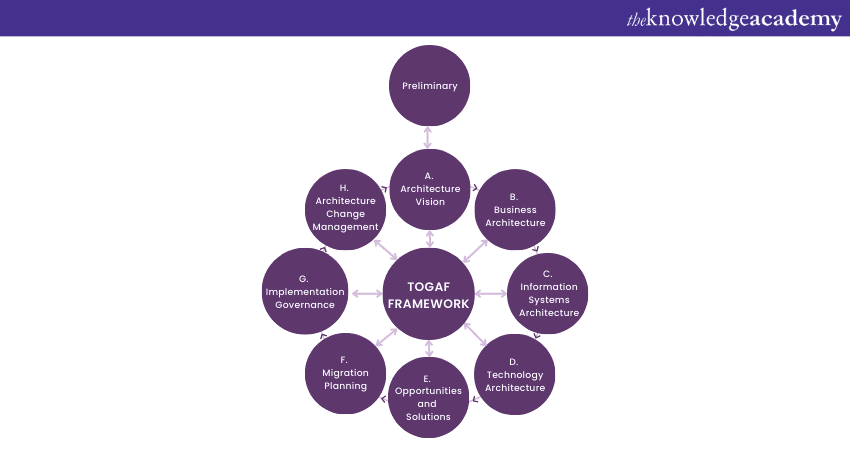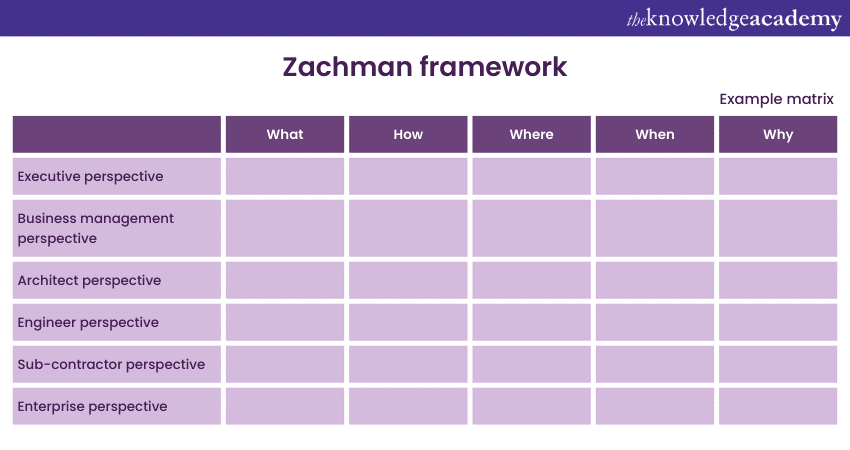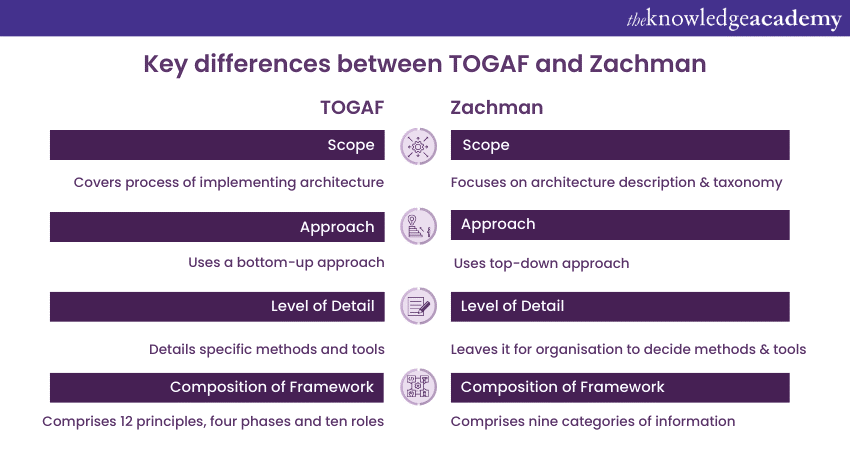We may not have the course you’re looking for. If you enquire or give us a call on +44 1344 203 999 and speak to our training experts, we may still be able to help with your training requirements.
We ensure quality, budget-alignment, and timely delivery by our expert instructors.

TOGAF and Zachman are two popular Enterprise Architecture (EA) frameworks, but there is always a debate about TOGAF vs Zachman. Both provide a structured strategy for building and managing an organisation's architecture, but some important distinctions exist between them.
TOGAF is a complete framework that offers a step-by-step procedure for building and implementing an EA. In contrast, Zachman is a matrix that provides a classification scheme for organising and maintaining various views of an organisation's architecture. According to The Open Group, over 120,000 TOGAF-certified individuals show the TOGAF framework's widespread application.
Organisations may find it challenging to choose between the two frameworks because each has benefits and disadvantages. In this blog on TOGAF vs Zachman, you will get an overview of TOGAF and Zachman & the key differences between them.
Table of Contents
1) What is an Enterprise Architecture Framework?
2) TOGAF: Architecture and Features
3) Zachman Architecture Framework
4) Difference between TOGAF and Zachman
5) Pros and Cons of TOGAF and Zachman
6) What to choose? TOGAF or Zachman
7) Conclusion
What is an Enterprise Architecture Framework?
Enterprise Architecture (EA) is a strategic planning and management practice that aligns a company's business goals and objectives with its information technology infrastructure and operations. EA assists organisations in staying up to date with the changing IT landscape and market trends.
It also helps organisations comprehend how their business processes, information systems, data, technology, and people interact with each other to achieve the organisation's goals. EA provides a comprehensive view of an organisation's architecture, considering all its components and their interdependence. It enables organisations to identify gaps and redundancies in their architecture and devise strategies for optimising their resources and processes.
Organisations use Enterprise Architecture Frameworks (EAF) like TOGAF and Zachman to enable all these. An enterprise architecture framework is described as a set of planning techniques, principles and processes that help organisations create an architecture framework for their business goals.
Start with your TOGAF journey with the TOGAF® Foundation And Practitioner Training.
TOGAF: Architecture and Features

TOGAF is a widely used enterprise architecture framework for businesses and organisations of any size. It offers a step-by-step, systematic implementation of the architecture. It is a framework that helps organisations design, plan, implement, and manage their technology infrastructure in an organised and efficient manner. You can think of it as a set of guidelines that provide a structured approach to developing and managing an organisation's technology architecture. It provides a common language and methodology that ensures all stakeholders clearly understand the organisation's technology goals and how they will be achieved.
By following TOGAF, organisations can ensure that their technology infrastructure aligns with their overall business objectives and is flexible to adapt to changing market conditions. It helps to minimise the risk of technology investments and ensures that the technology architecture is scalable, interoperable, and sustainable.
TOGAF was introduced in 1995, inspired by the U.S. Department of Defense's EAF, the Technical Architecture Framework for Information Management (TAFIM). Now, TOGAF is the go-to choice for many organisations. The reason for this massive success lies in the Architecture Development Model (ADM), which is the core of TOGAF. Understanding TOGAF Architecture Building Blocks is crucial, as they help organisations structure and implement the ADM effectively to achieve enterprise architecture goals.
Architecture Development Model in TOGAF
According to TOGAF forms a fundamental aspect of an organisation's systems. It is a part of the firm's components and its relationship to different elements of the environment, and it governs the principles of design and evolution.
TOGAF defines architecture as the overall design and structure of a company's technology infrastructure. It includes all aspects of the technological environment, such as hardware, software, networks, data, and applications. TOGAF Architecture Principles offers a systematic method for designing, planning, and deploying technological infrastructure to guarantee that it fulfils the organisation's needs efficiently and effectively.
The TOGAF framework's core is the ADM, which defines and implements the enterprise architecture. The ADM provides a step-by-step approach for developing and maintaining enterprise architecture aligned with the organisation's business goals and objectives.
It is an iterative process that includes the establishment of an enterprise architecture, the development of a target architecture, and the execution of the target architecture. Various architectural artefacts, including architectural principles, standards, models, and building blocks, are generated and refined throughout the ADM. The ADM is intended to be adaptable, allowing organisations to tailor it to their unique needs and situations.
Pillars of TOGAF
There are three pillars of TOGAF, shown below:
a) Enterprise Continuum
b) Architecture Development Model (ADM)
c) Domains of Enterprise Architecture
d) Business Architecture
e) Data Architecture
f) Applications Architecture
g) Technical Architecture
The Enterprise Continuum provides a framework for organising and classifying architectural artefacts and other related information within an organisation. It manages an enterprise's architecture portfolio and ensures that architecture work is consistent and aligned with the overall business objectives.
The Enterprise Architecture domains are categorised into four main areas, which are commonly referred to as 'BDAT areas':
a) Business Architecture: This area defines the business strategy and organisation, essential business processes, governance, and standards.
b) Data Architecture: This area documents the structure of logical and physical data assets and any related data management resources.
c) Applications Architecture: This area provides a plan for deploying individual systems, including interactions among application systems and their relationships to essential business processes.
d) Technical Architecture (Technology Architecture): This area describes the necessary hardware, software, and network infrastructure to support the deployment of mission-critical applications.
TOGAF or ITIL? Discover which framework aligns best with your IT goals
Acquire the necessary skills to use the TOGAF standard with other frameworks with TOGAF® BA Foundation Training.
Zachman Architecture Framework

The Zachman framework, created by John Zachman in the 1980s, is a well-known and frequently used enterprise architecture (EA) framework. By categorising an organisation's architecture, the framework gives a disciplined way of organising and controlling it.
The Zachman framework is a two-dimensional matrix of six rows and six columns. It is more of a template rather than a methodology. It comprises a two-dimensional matrix with six rows and six columns. The rows represent the 'perspective', and the columns represent the fundamental questions.
The following are represented in the rows:
a) Executive perspective
b) Business management perspective
c) Architect perspective
d) Engineer perspective
e) Technician perspective
f) Enterprise perspective
The following are represented in the columns:
a) Who: This focuses on the individuals and organisations involved in architecture, such as stakeholders and business owners.
b) What: This focuses on the data and information generated and consumed by the architecture.
c) Where: This concerns the physical places, and infrastructure utilised to support the design.
d) When: This focuses on the sequencing and timing of actions inside the architecture.
e) Why: This focuses on the architecture's goals and objectives
f) How: This focuses on the methods, procedures, and technologies utilised to implement the architecture.
g) Who: This focuses on the individuals and organisations involved in architecture, such as stakeholders and business owners.
Difference between TOGAF and Zachman

TOGAF and the Zachman Framework are two popular EA frameworks for developing and implementing enterprise architecture. While both frameworks aim to improve an organisation's architecture, they differ in several important ways:
Scope
TOGAF covers the architectural description and the process of implementing and managing the architecture, making it more comprehensive than the Zachman Framework. On the other hand, the Zachman Framework focuses primarily on the architectural description, providing a taxonomy and matrix for organising information.
Level of Detail
TOGAF takes a more detailed approach to the architecture development process, focusing on specific methodologies and tools for various aspects of the architecture. On the other hand, the Zachman Framework is less prescriptive, leaving it up to the organisation to determine which methodologies and tools to employ.
Structure
TOGAF has a four-layer architecture structure that describes the various aspects of enterprise architecture. In contrast, Zachman Framework has a matrix structure that organises the different elements of architecture based on their perspectives and views.
Focus
TOGAF focuses on design principles and details of the implementation of the processes, and Zachman, on the other hand, is more focused on organising and defining the data. TOGAF focuses on business and IT alignment, emphasising delivering business value through IT. On the other hand, the Zachman Framework is more focused on developing a taxonomy for describing the various aspects of architecture and their relationships to one another.
Models used
TOGAF uses three models:
1) Business Model
2) Technical Architecture Model (TAM)
3) Application Portfolio Management Model (APM)
Compared to TOGAF, Zachman uses only one data model with six subgroups corresponding to each of the six perspectives from the matrix.
Way of handling change over time
Here, both allow for changes over time, but the process for documenting and incorporating the change is different. In TOGAF, the changes are well documented so that they can be tracked effectively over time. Zachman's framework is designed to allow for change without needing to rebuild the existing structure.
Approach
TOGAF uses a bottom-up approach, while Zachman uses a top-down approach. TOGAF starts at the bottom by collecting all the relevant data about the organisation's processes. It integrates all the collected data and then builds a complete picture of the enterprise architecture. Zachman starts from the top with a high-level view of the organisation's processes and then moves to more specific details.
Usage
TOGAF is typically used for a smaller organisation with relatively fewer stakeholders involved and fewer moving parts within the organisation. Zachman is used in large organisations with many departments, each with its own requirements and goals.
Composition of the framework
TOGAF comprises 12 principles, four phases and ten roles that guide creating strategies and plans to improve business. The Zachman framework consists of nine categories of information that can be applied to any organisation, irrespective of its size and industry.
Learn the skills needed to develop enterprise architecture and understand the role of an architecture board and its responsibilities with TOGAF® Foundation and Practitioner - Foundation Training.
Pros and Cons of TOGAF and Zachman
Comparing TOGAF vs Zachman, both are great frameworks, but they have certain strengths and drawbacks which you should be aware of to make an informed decision.
Pros and Cons of TOGAF
Pros
The following are the benefits of using TOGAF:
1) Offers a standardised approach to developing and implementing enterprise architecture.
2) It establishes a common language, methodology, and set of tools and templates throughout the organisation.
3) It is a flexible framework tailored to the organisation's needs and goals. It enables organisations to select which framework components to use and adapt as needed.
4) It places a strong emphasis on aligning business and IT strategies, with a focus on delivering business value through IT.
5) Enables organisations to prioritise their investments and initiatives in accordance with their business goals.
6) Encourages collaboration among various departments and stakeholders, focusing on developing a shared vision and understanding of the enterprise architecture.
Cons
The following are the limitations of TOGAF:
1) TOGAF is a complex framework that can be challenging to implement and maintain, especially for smaller organisations or those with limited resources.
2) Implementing TOGAF can be time-consuming and costly, requiring significant investment in training, tools, and resources.
3) TOGAF may be overly prescriptive for some organisations, with too many guidelines and procedures that can stifle creativity and innovation.
4) It may not provide enough value to justify the investment required to implement it, especially for organisations with simpler IT environments or less complex business models.
Pros and Cons of Zachman
Pros
The following are the benefits of using Zachman:
1) It improves communication between the team and among professionals.
2) It recognises that there is no single "one size fits all" design for everyone's needs.
3) Recognises the benefits and drawbacks of not developing a single architectural depiction.
4) Reconsiders the traditional application development process and has better processes and tools for producing architectural representations.
5) It compares a wide range of tools and approaches.
Cons
The following are the limitations of Zachman:
1) It can often lead to heavy documenting.
2) It is not ideal and well-received in the development community.
3) It favours data-centric methodologies

What to choose? TOGAF or Zachman
When choosing between TOGAF vs Zachman, it is essential to understand the organisation's approach and needs to arrive at the right methodology. TOGAF provides a systematic approach for creating and improving the entire enterprise architecture for the organisation.
When to use TOGAF:
1) When the organisation needs a complete transformation or improvement in the architecture and operations.
2) To sync the organisation’s processes with present goals.
3) To help in developing or creating an architecture from inception to implementation.
It is well suited for large organisations. Because it heavily relies on theory, implementing TOGAF requires an adequate number of TOGAF-trained professionals. This flexible framework encourages agile methodology, making it ideal for organisations that use the agile method.
When to use Zachman:
1) To make communication easier in the organisation.
2) The organisation is focused on defining and planning the subsets of the enterprise architecture.
3) The size of the organisation is relatively smaller.
Zachman's goal is to identify and organise the artefacts that represent a company's architecture, and it is more descriptive and provides a taxonomy for organising architectural artefacts. It focuses on the IT domain while it applies to other sectors of an organisation.
Also, consider these points before deciding between TOGAF vs Zachman.
1) TOGAF is more adaptable to varied organisational structures and cultures, whereas Zachman is more rigid and requires a more organised approach.
2) TOGAF is a more mature framework with a well-established methodology and community, whereas Zachman is a newer framework with a smaller practitioner community.
Based on these factors, organisations can choose TOGAF or Zachman; however, there is no compulsion to choose only one. Organisations can use both as they function well together.
Conclusion
When talking about TOGAF vs Zachman, both provide useful frameworks for building and managing an organisation's architecture, but they have their pros and cons. TOGAF is a comprehensive and adaptable framework that provides a step-by-step process for constructing an EA. In contrast, Zachman offers a classification scheme for organising and maintaining various views of an organisation's architecture. Choosing between the two is determined by the organisation's specific demands and goals. Regardless of your chosen framework, implementing an EA framework will greatly benefit your organisation by aligning business and IT, increasing productivity, and driving innovation.
Get an in-depth knowledge of implementing the architecture efficiently TOGAF® Foundation And Practitioner Training.
Upcoming Business Improvement Resources Batches & Dates
Date
 TOGAF® Foundation and Practitioner Training
TOGAF® Foundation and Practitioner Training
Sat 3rd May 2025, Sun 4th May 2025
Tue 6th May 2025
Sat 17th May 2025, Sun 18th May 2025
Mon 19th May 2025
Tue 27th May 2025
Sat 7th Jun 2025, Sun 8th Jun 2025
Mon 9th Jun 2025
Mon 16th Jun 2025
Sat 21st Jun 2025, Sun 22nd Jun 2025
Mon 23rd Jun 2025
Mon 30th Jun 2025
Sat 5th Jul 2025, Sun 6th Jul 2025
Mon 14th Jul 2025
Sat 19th Jul 2025, Sun 20th Jul 2025
Mon 21st Jul 2025
Mon 28th Jul 2025
Sat 2nd Aug 2025, Sun 3rd Aug 2025
Mon 11th Aug 2025
Sat 16th Aug 2025, Sun 17th Aug 2025
Mon 18th Aug 2025
Tue 26th Aug 2025
Sat 6th Sep 2025, Sun 7th Sep 2025
Mon 8th Sep 2025
Mon 15th Sep 2025
Sat 20th Sep 2025, Sun 21st Sep 2025
Mon 22nd Sep 2025
Mon 29th Sep 2025
Sat 4th Oct 2025, Sun 5th Oct 2025
Mon 13th Oct 2025
Sat 18th Oct 2025, Sun 19th Oct 2025
Mon 20th Oct 2025
Mon 27th Oct 2025
Sat 8th Nov 2025, Sun 9th Nov 2025
Mon 10th Nov 2025
Mon 17th Nov 2025
Sat 22nd Nov 2025, Sun 23rd Nov 2025
Mon 24th Nov 2025
Sat 6th Dec 2025, Sun 7th Dec 2025
Mon 8th Dec 2025
Mon 15th Dec 2025
Sat 20th Dec 2025, Sun 21st Dec 2025






 Top Rated Course
Top Rated Course


 If you wish to make any changes to your course, please
If you wish to make any changes to your course, please


